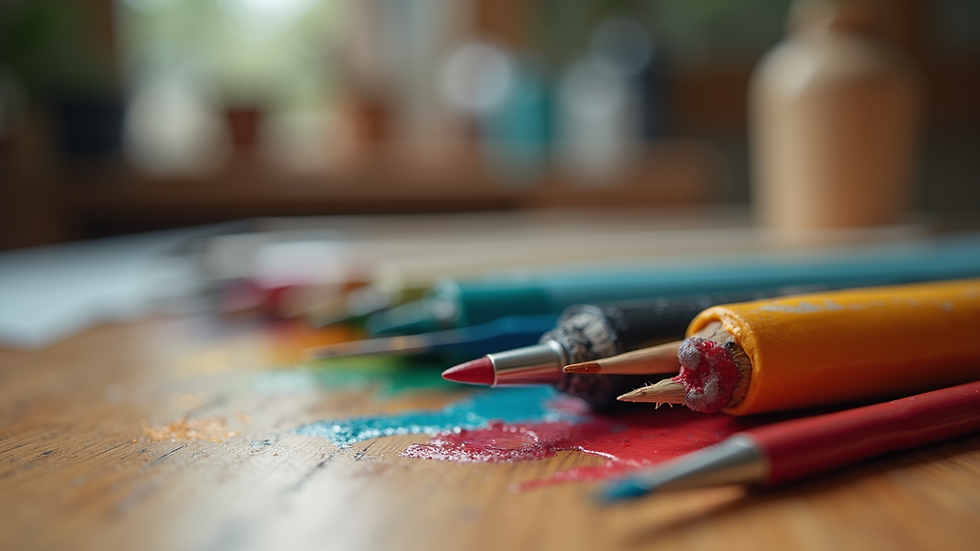Master Essential Acrylic Painting Techniques
- samikshaartstudio
- Jul 29
- 4 min read
Acrylic painting is one of the most exciting and accessible art forms you can explore. Whether you’re just starting out or looking to refine your skills, mastering the basics opens up a world of creative possibilities. I remember the first time I picked up a brush loaded with acrylic paint - the vibrant colours and quick drying time instantly hooked me. Today, I want to share some essential tips and techniques that will help you paint with confidence and joy.
Understanding Acrylic Painting Basics
Before diving into techniques, it’s important to get familiar with the fundamentals of acrylic paint. Acrylics are water-based, fast-drying paints that can mimic the look of both oil and watercolor depending on how you use them. They are versatile, easy to clean up, and perfect for beginners and professionals alike.
Here are some key points to keep in mind:
Drying Time: Acrylics dry quickly, usually within 15-30 minutes depending on thickness. This means you can layer colours fast but also need to work efficiently.
Surface Options: You can paint on canvas, paper, wood, fabric, and more. Each surface affects how the paint behaves.
Brush Types: Synthetic brushes work best with acrylics. Flat, round, and filbert brushes each create different strokes.
Mediums and Additives: You can mix acrylics with gels, pastes, or retarders to change texture, drying time, and finish.
Getting comfortable with these basics sets a strong foundation for exploring more advanced techniques.

Essential Acrylic Painting Techniques to Try
Now that you know the basics, let’s explore some practical techniques that will elevate your painting skills. These methods are easy to practice and can be combined to create stunning effects.
1. Dry Brush Technique
This involves using a dry brush with very little paint to create scratchy, textured strokes. It’s great for adding highlights, texture, or a rough look to your painting.
Load your brush with paint and then wipe most of it off on a paper towel.
Lightly drag the brush over the surface.
Experiment with different brush shapes for varied textures.
2. Wet-on-Wet Blending
Acrylics dry fast, but if you work quickly, you can blend colours directly on the canvas.
Apply a base colour.
While it’s still wet, add another colour next to it.
Use a clean brush or a soft blending brush to gently mix the edges.
This technique is perfect for smooth gradients and soft backgrounds.
3. Glazing
Glazing means applying thin, transparent layers of paint over a dry base layer to create depth and luminosity.
Mix paint with a glazing medium or water to thin it.
Apply a transparent layer over your painting.
Let it dry before adding more layers.
Glazing is excellent for creating shadows, highlights, and subtle colour shifts.
4. Impasto
Impasto is all about thick, textured paint application that stands out from the canvas.
Use heavy body acrylics or add a texture medium.
Apply paint thickly with a palette knife or brush.
Build up layers for a 3D effect.
This technique adds drama and tactile interest to your work.
5. Stippling
Stippling uses small dots or dabs of paint to build up texture or shading.
Use a stiff brush or sponge.
Dab paint repeatedly on the surface.
Vary the pressure and paint amount for different effects.
Stippling works well for foliage, fur, or textured backgrounds.

Do you wet your brush when using acrylic paint?
This is a common question and the answer depends on the effect you want to achieve. Unlike watercolour, acrylic paint is thicker and can be used straight from the tube or thinned with water or mediums.
Wetting your brush: Dipping your brush in water before picking up paint can help create smoother strokes and prevent the paint from drying too fast on the brush.
Using dry brushes: For techniques like dry brushing, you want a dry brush with minimal paint.
Water as a thinner: Adding water to acrylic paint thins it but too much water can break down the paint’s binder, making it less durable.
Mediums over water: For better control and finish, use acrylic mediums instead of water to thin paint.
In my experience, lightly wetting the brush before painting helps with blending and smoother application, especially when working on larger areas.
Tips for Choosing the Right Tools and Materials
Having the right tools makes a big difference in your painting experience. Here’s what I recommend:
Brushes: Invest in a variety of synthetic brushes - flats for broad strokes, rounds for detail, and filberts for blending.
Paint Quality: Student-grade acrylics are fine for practice, but artist-grade paints have richer pigments and better consistency.
Canvas or Paper: Start with acrylic paper or canvas boards for practice. Canvas stretched on a frame is ideal for finished pieces.
Palette: Use a stay-wet palette or a wet palette to keep your paints moist longer.
Mediums: Experiment with gloss, matte, and texture mediums to customize your paint.
Remember, you don’t need expensive supplies to start. Just a few good brushes and basic paints will get you going.

Keep Practicing and Exploring Your Style
The best way to master acrylic painting is to keep experimenting and learning. Try different subjects, from landscapes to abstracts, and play with the techniques I’ve shared. Don’t be afraid to make mistakes - every stroke teaches you something new.
If you want to dive deeper into acrylic painting techniques, consider joining a class or workshop. Hands-on guidance can accelerate your progress and inspire fresh ideas.
Above all, enjoy the process. Painting is not just about the final piece but the joy of creating and expressing yourself. So grab your brushes, mix your colours, and let your creativity flow!
Happy painting!







Comments